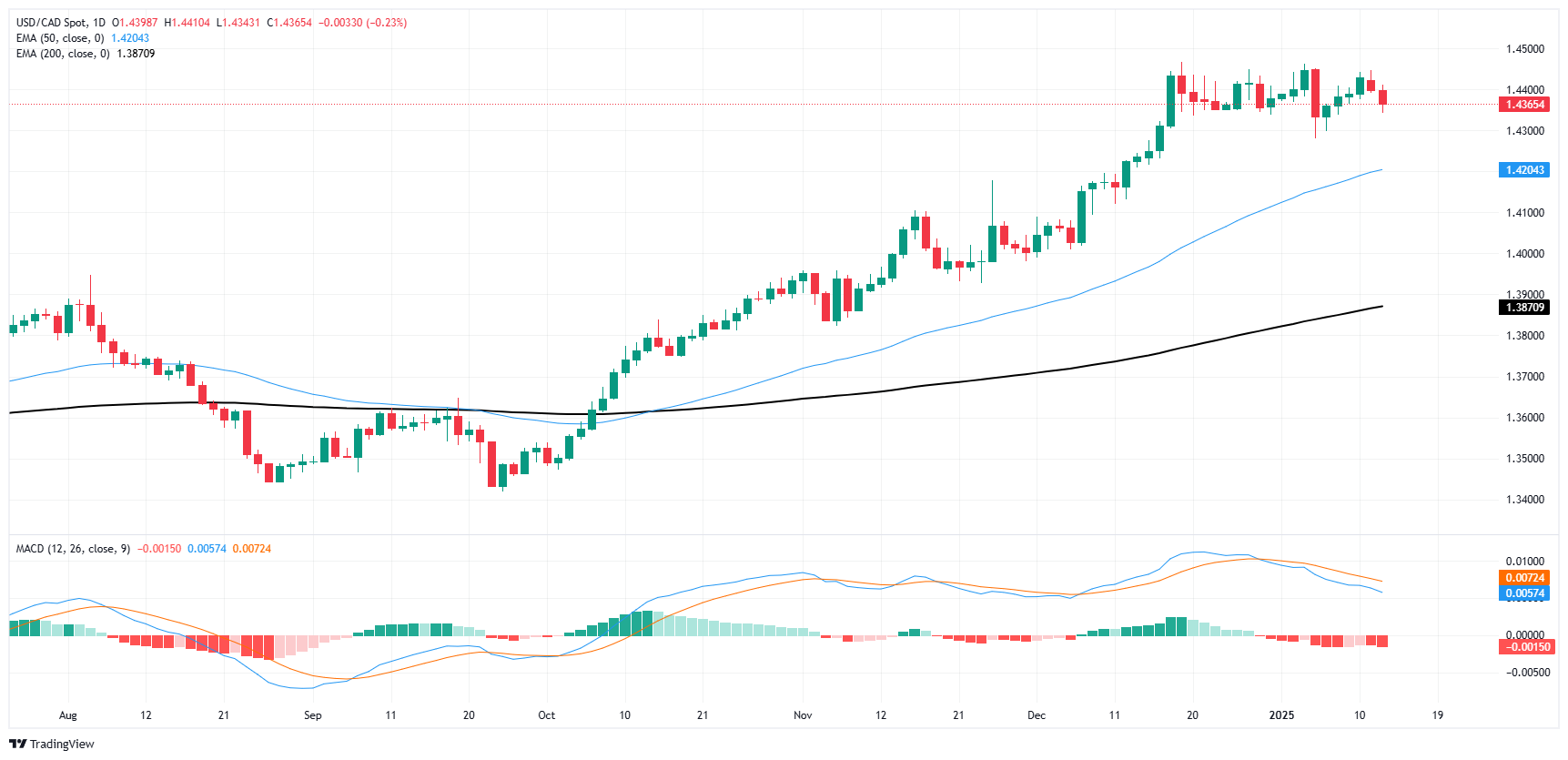Canadian Dollar catches some relief as Greenback eases
- The Canadian Dollar gained a slim 0.3%, but remains mired in congestion.
- Canada remains absent from the data docket on Tuesday.
- Cooler-than-expected US PPI inflation figures calm market tensions.
The Canadian Dollar (CAD) caught a thin bid on Tuesday, bostlered by a general easing in US Dollar flows after US Producer Price Index (PPI) inflation accelerated at a slower pace than markets expected in December. Traders’ hopes that this week’s US Consumer Price Index (CPI) print will also come in below expectations have been reignited following the PPI print, although the figure is ultimately expected to rise over previous periods.
Canada remains almost entirely absent from the economic data release schedule this week, with only low-tier data on the offering. The Bank of Canada (BoC) is broadly expected to continue trimming rates while the Federal Reserve (Fed) is slated to hold off on any further rates cuts through the first half of 2025, which will widen the CAD’s rate differential against the Greenback.
Daily digest market movers: CAD gets a step up thanks to US data
- The Canadian Dollar is up, forcing the USD/CAD pair back down below the 1.400 handle, but market flows remain one-sided as the Loonie lacks intrinsic momentum.
- PPI inflation figures eased broadly below expectations in December, with headline PPI printing at just 0.2% MoM.
- Investors were expecting a downtick to 0.3% from the previous 0.4%.
- Core PPI, excluding price increases in volatile food and energy prices, was flat in December versus the forecast of 0.3% and 0.2% last.
- headline PPI inflation rose to 3.3% YoY versus the previous figure of 3.0%, while core PPI accelerated to 3.5% YoY compared to the previous 3.4%.
Canadian Dollar price forecast: CAD set to continue rising as long as market holds off on USD bidding
The Canadian Dollar’s gain on Tuesday amounted to one-third of one percent, a scant percentage with the Loonie parked near multi-year lows against the Greenback. Loonie bidders are struggling to push USD/CAD back into the latest swing low into the 1.4300 handle, but USD bulls continue to get wrapped up in a congestion zone around 1.4400, stamping in a tight consolidation range.
A lack of momentum is bleeding clear signals out of momentum oscillators, and long-run moving averages are beginning to catch up to bids, leaving candlesticks exposed to a difficult chart space looking forward.
USD/CAD daily chart
Canadian Dollar FAQs
The key factors driving the Canadian Dollar (CAD) are the level of interest rates set by the Bank of Canada (BoC), the price of Oil, Canada’s largest export, the health of its economy, inflation and the Trade Balance, which is the difference between the value of Canada’s exports versus its imports. Other factors include market sentiment – whether investors are taking on more risky assets (risk-on) or seeking safe-havens (risk-off) – with risk-on being CAD-positive. As its largest trading partner, the health of the US economy is also a key factor influencing the Canadian Dollar.
The Bank of Canada (BoC) has a significant influence on the Canadian Dollar by setting the level of interest rates that banks can lend to one another. This influences the level of interest rates for everyone. The main goal of the BoC is to maintain inflation at 1-3% by adjusting interest rates up or down. Relatively higher interest rates tend to be positive for the CAD. The Bank of Canada can also use quantitative easing and tightening to influence credit conditions, with the former CAD-negative and the latter CAD-positive.
The price of Oil is a key factor impacting the value of the Canadian Dollar. Petroleum is Canada’s biggest export, so Oil price tends to have an immediate impact on the CAD value. Generally, if Oil price rises CAD also goes up, as aggregate demand for the currency increases. The opposite is the case if the price of Oil falls. Higher Oil prices also tend to result in a greater likelihood of a positive Trade Balance, which is also supportive of the CAD.
While inflation had always traditionally been thought of as a negative factor for a currency since it lowers the value of money, the opposite has actually been the case in modern times with the relaxation of cross-border capital controls. Higher inflation tends to lead central banks to put up interest rates which attracts more capital inflows from global investors seeking a lucrative place to keep their money. This increases demand for the local currency, which in Canada’s case is the Canadian Dollar.
Macroeconomic data releases gauge the health of the economy and can have an impact on the Canadian Dollar. Indicators such as GDP, Manufacturing and Services PMIs, employment, and consumer sentiment surveys can all influence the direction of the CAD. A strong economy is good for the Canadian Dollar. Not only does it attract more foreign investment but it may encourage the Bank of Canada to put up interest rates, leading to a stronger currency. If economic data is weak, however, the CAD is likely to fall.
